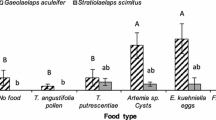Abstract
Female lifespan and reproduction, in terms of numberof larvae produced, of the soil-dwelling predatorymite Lasioseius fimetorum Karg (Acari:Podocinidae) fed on mould mites (Tyrophagusputrescentiae [Schrank] [Acarina: Acaridae]) wereinvestigated by laboratory experiments at 20 °C,as were the mite's consumption rates of various prey.After a preoviposition period of 10.7 days, L.fimetorum produced progeny at a daily rate of 0.7.The oviposition period lasted 23.6 days and a total of19.4 progeny were produced per female. Females livedfor 38.6 days. Eggs of the Collembola Isotomurusspp. (Collembola: Isotomidae) were consumed in thelargest amount by L. fimetorum followed by mouldmite nymphs, larvae and pupae of thrips (Frankliniella occidentalis [Pergande] [Thysanoptera:Thripidae]), eggs of the Collembola Micrisotomaspp. (Collembola: Isotomidae), Isotomurus spp.nymphs and sciarid larvae (Bradysia pauperaTuomikoski and B. tritici (Coquillet) [Diptera:Sciaridae]). Immature drain flies (Psychoda spp.[Diptera: Psychodidae]) were not consumed by L.fimetorum. The suitability of L. fimetorum forbiological control of glasshouse pests withsoil-dwelling stages is discussed in comparison withanother predatory mite Hypoaspis miles Berlese(Acarina: Hypoaspididae).
Similar content being viewed by others
References
Brødsgaard, H.F. and A. Enkegaard, 1995. Biological control of aphids and thrips on potted Gerbera (Danish, English summary). 12th Danish Plant Protection Conference / Pests and Diseases. SP Report 4: 257-266.
Brødsgaard, H.F. and A. Enkegaard, 1997. Interactions among polyphagous anthocorid bugs used for thrips control and other beneficials in multi-species biological pest management systems. In: S.G. Pandalai (ed.), Recent Res. Devel. in Entomol. 1. Research Signpost, Trivandrum. pp. 153-160.
Brødsgaard, H.F., M.A. Sardar and A. Enkegaard, 1996. Prey preference of Hypoaspis miles (Berlese) (Acarina: Hypoaspididae): non-interference with other beneficials in glasshouse crops. IOBC/WPRS Bull. 19: 23-26.
Bund, C.F. van de, 1972. Enkele waarnemingen aan Lasioseius fimetorum Karg 1971 in een gezelschap van mijten, springstaarten en nematoden tussen de wortels van witte klaver. Entomologische Berichten 32: 6-12.
Chambers, R.J., E.M. Wright and R.J. Lind, 1993. Biological control of glasshouse sciarid flies (Bradysia spp.) with the predatory mite, Hypoaspis miles, on cyclamen and poinsettia. Biocontr. Sci. Technol. 3: 285-293.
Enkegaard, A. and H.F. Brødsgaard, 1994. Biological control of spider mites and thrips on potted Gerbera (Danish, English summary). 11th Danish Plant Protection Conference / Pests and Diseases. SP Report 7: 307-320.
Enkegaard, A., M.A. Sardar and H.F. Brødsgaard, 1997. The predatory mite Hypoaspis miles: biological and demographic characteristics on two prey species, the mushroom sciarid fly, Lycoriella solani, and the mould mite, Tyrophagus putrescentiae. Ent. Exp. Appl. 82: 135-146.
Glockemann, B., 1992. Biological control of Frankliniella occidentalis on ornamental plants using predatory mites. EPPO Bull. 22: 397-404.
Imbriani, J.L. and R. Mankau, 1983. Studies on Lasioseius scapulatus, a Mesostigmatid mite predaceous on nematodes. J. Nematology 15: 523-528.
Jakobsen, J., 1989. Mass rearing of the predatory mite Amblyseius barkeri for control of thrips (Danish, English summary). 6th Danish Plant Protection Conference / Pests and Diseases. Planteværnscentret, Lyngby. pp. 77-82.
Karg, W., 1980. Die Raubmilbengattung Lasioseius Berlese, 1916. Zool. Jb. Syst. 107: 344-367.
Karg, W., 1994. Raubmilben, nützliche Regulatoren im Naturhaushalt: Lebensweise, Artenbestimmung und Nutzung. Westarp Wissenschafen, Magdeburg. 206 p.
Lenteren, J.C. van and A.J.M. Loomans, 1999. Biological control of thrips: how far are we? IOBC/WPRS Bull. 22: 141-144.
Naeem, S., D.S. Dobkin and B.M. OConnor, 1985. Lasioseius mites (Acari: Gamasida: Ascidae) associated with hummingbird-pollinated flowers in Trinidad, West Indies. International J. Entomol. 27: 338-353.
Nawar, M.S., M.A. Rakha and F.S. Ali, 1990. Laboratory studies on the predaceous mite Lasioseius bispinosus Evans (Acari: Mesostigmata: Ascidae) on various kinds of food substances. Bull. Soc. Ent. Egypte. 69: 247-255.
Ohmer, C., A. Fain and K.-L. Schuchmann, 1991. New ascid mites of the genera Rhinoseius Baker and Yunker, 1964 and Lasioseius Berlese, 1923 (Acari: Gamasida: Ascidae) associated with hummingbirds or hummingbird-pollinated flowers in southwestern Colombia. J. Natural Hist. 25: 481-497.
Parrella, M.P. and B. Murphy, 1996.Western flower thrips: identification, biology and research on the development of control strategies. IOBC/WPRS Bull. 19: 115-118.
Rasmy, A.H., A.K. Nasr and A.S. Reda, 1987. Reproductive response and development of three soil predaceous mites utilising the acarid mite Tyrophagus casei Oud. as an alternate diet. Anz. Schädlingskde., Pflanzenschutz, Umweltschutz 60: 92-94.
Shereef, G.M., Z.R. Soliman and A.M. Afifi, 1980. Economic importance of the mite Hypoaspis miles (Berlese) (Mesostigmata: Laelapidae) and its life history. Bull. Soc. Ent. Egypte 30: 103-108.
Walter, D.E. and E.E. Lindquist, 1989. Life history and behavior of mites in the genus Lasioseius (Acari: Mesostigmata: Ascidae) from grassland soils in Colorado, with taxonomic notes and description of a new species. Can. J. Zool. 67: 2797-2813.
Wright, E.M. and R.J. Chambers, 1994. The biology of the predatory mite Hypoaspis miles (Acari: Laelapidae), a potential biological control agent of Bradysia paupera (Diptera: Sciaridae). Entomophaga 39: 225-235.
Ydergaard, S., A. Enkegaard and H.F. Brødsgaard, 1997. The predatory mite Hypoaspis miles: temperature dependent life table characteristics on a diet of sciarid larvae, Bradysia paupera and B. tritici. Ent. Exp. Appl. 85: 177-187.
Author information
Authors and Affiliations
Corresponding author
Rights and permissions
About this article
Cite this article
Enkegaard, A., BrØdsgaard, H. Lasioseius Fimetorum: a soil-dwelling predator of glasshouse pests?. BioControl 45, 285–293 (2000). https://doi.org/10.1023/A:1009981920402
Issue Date:
DOI: https://doi.org/10.1023/A:1009981920402



